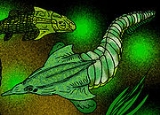
Neeyambaspis enigmatica
Encyclopedia
Neeyambaspis enigmatica ("Enigmatic shield of Neeyamba Hill") is the lesser known of the two species of pituriaspid agnatha
ns. The species lived in estuaries during the Middle Devonian
, in what is now the Georgina Basin
of Western Queensland
, Australia
.
N. enigmatica differed from its relative, Pituriaspis doylei
, in that the headshield was triangular, rather than elongated, that the rostrum was much smaller and shorter, and that there was no cavity at the base of the rostrum that suggested the presence of nasal openings.
Agnatha
Agnatha is a superclass of jawless fish in the phylum Chordata, subphylum Vertebrata. The group excludes all vertebrates with jaws, known as gnathostomes....
ns. The species lived in estuaries during the Middle Devonian
Devonian
The Devonian is a geologic period and system of the Paleozoic Era spanning from the end of the Silurian Period, about 416.0 ± 2.8 Mya , to the beginning of the Carboniferous Period, about 359.2 ± 2.5 Mya...
, in what is now the Georgina Basin
Georgina Basin
The Georgina Basin is a large intracratonic sedimentary basin in central and northern Australia, lying mostly within the Northern Territory and partly within Queensland. It is named after the Georgina River which drains part of the basin. Deposition of locally up to ca...
of Western Queensland
Queensland
Queensland is a state of Australia, occupying the north-eastern section of the mainland continent. It is bordered by the Northern Territory, South Australia and New South Wales to the west, south-west and south respectively. To the east, Queensland is bordered by the Coral Sea and Pacific Ocean...
, Australia
Australia
Australia , officially the Commonwealth of Australia, is a country in the Southern Hemisphere comprising the mainland of the Australian continent, the island of Tasmania, and numerous smaller islands in the Indian and Pacific Oceans. It is the world's sixth-largest country by total area...
.
N. enigmatica differed from its relative, Pituriaspis doylei
Pituriaspis doylei
Pituriaspis doylei was one of two known species of jawless fish belonging to the Class Pituriaspida, and is the better known of the two. The species lived in estuaries during the Middle Devonian, in what is now the Georgina Basin of Western Queensland, Australia.The first specimens of P...
, in that the headshield was triangular, rather than elongated, that the rostrum was much smaller and shorter, and that there was no cavity at the base of the rostrum that suggested the presence of nasal openings.

